Three Mile Island Nuclear Generating Station
Three Mile Island Nuclear Generating Station (TMI) is a closed nuclear power plant on Three Mile Island in Londonderry Township, Pennsylvania, on the Susquehanna River just south of Harrisburg. It had two separate units, TMI-1 (owned by Exelon Generation) and TMI-2 (owned by FirstEnergy Corp).[3] The plant was site of the most significant accident in United States commercial nuclear energy when, on March 28, 1979, TMI-2 suffered a partial meltdown. According to the Nuclear Regulatory Commission (NRC) report, the accident resulted in no deaths or injuries to plant workers or in nearby communities.[4] Follow-up epidemiology studies have linked no incidents of cancer to the accident.[5][6][7][8]
| Three Mile Island Nuclear Generating Station | |
|---|---|
-2.jpg) The Three Mile Island NPP on Three Mile Island, circa 1979 | |

| |
| Country | United States |
| Location | Londonderry Township, Dauphin County, Pennsylvania |
| Coordinates | 40°9′14″N 76°43′29″W |
| Status | Being decommissioned |
| Construction began | Unit 1: May 18, 1968 Unit 2: November 1, 1969 |
| Commission date | Unit 1: September 2, 1974 Unit 2: December 30, 1978 |
| Decommission date | Unit 1: September 20, 2019 Unit 2: March 28, 1979 |
| Construction cost | $1.557 billion (2007 USD)[1] ($2.00 billion in 2018 dollars[2]) |
| Owner(s) | Unit 1: Exelon Unit 2: FirstEnergy |
| Operator(s) | Exelon Nuclear |
| Nuclear power station | |
| Reactor type | PWR |
| Reactor supplier | Babcock & Wilcox |
| Cooling towers | 4 × Natural Draft |
| Cooling source | Susquehanna River |
| Thermal capacity | 1 × 2568 MWth |
| Power generation | |
| Units operational | 1 × 819 MW |
| Make and model | B&W LLP (DRYAMB) |
| Units decommissioned | 1 × 880 MW |
| Nameplate capacity | 819 MW |
| Capacity factor | 95.65% (2017) 73.25% (lifetime) |
| Annual net output | 6862 GWh (2017) |
| External links | |
| Website | Three Mile Island |
| Commons | Related media on Commons |
The reactor core of TMI-2 has since been removed from the site, but the site has not been decommissioned.[9] In July 1998, Amergen Energy (now Exelon Generation) agreed to purchase TMI-1 from General Public Utilities for $100 million.[10]
Three Mile Island is so named because it is located three miles downriver from Middletown, Pennsylvania.[11] The plant was originally built by General Public Utilities Corporation, later renamed GPU Incorporated.[12] The plant was operated by Metropolitan Edison Company (Met-Ed), a subsidiary of the GPU Energy division. During 2001, GPU Inc. merged with FirstEnergy Corporation.[13]
Exelon was operating Unit 1 at Three Mile Island at a loss since 2015.[14] In 2017 the company said it would consider ceasing operations at Unit 1 because of high costs unless there was government action;[15][16] it shut down in 2019.[17]
Unit 2, which has been dormant since the accident in 1979, is still owned by FirstEnergy, and it is estimated to close in 2036.[18]
Emergency zones and nearby population
The NRC defines two emergency planning zones around nuclear power plants: a plume exposure pathway zone with a radius of 10 miles (16 km), concerned primarily with exposure to, and inhalation of, airborne radioactive contamination, and an ingestion pathway zone of about 50 miles (80 km), concerned primarily with ingestion of food and liquid contaminated by radioactivity.[19]
The 2010 U.S. population within 10 miles (16 km) of Three Mile Island was 211,261, an increase of 10.9 percent in a decade, according to an analysis of U.S. Census data for MSNBC. The 2010 U.S. population within 50 miles (80 km) was 2,803,322, an increase of 10.3 percent since 2000. Cities within 50 miles include Harrisburg (12 miles to city center), York (13 miles to city center), and Lancaster (24 miles to city center).[20]
Three Mile Island Unit 1
The Three Mile Island Unit 1 is a pressurized water reactor designed by Babcock & Wilcox with a net generating capacity of 819 MWe. The initial construction cost for TMI-1 was US$400 million, equal to $2.07 billion in 2018 dollars.[21] Unit 1 first came online on April 19, 1974, and began commercial operations on September 2, 1974.[22] TMI-1 is licensed to operate for 40 years from its first run, and in 2009, was extended 20 years, which means it could have operated until April 19, 2034.[23][24]
TMI-1 had a closed-cycle cooling system for its main condenser using two natural draft cooling towers. Makeup water was drawn from the river to replace the water lost via evaporation in the towers. Once-through cooling with river water is used for the service water system which cools auxiliary components and removed decay heat when the reactor was shut down. When TMI-2 suffered its accident in 1979, TMI-1 was offline for refueling. It was brought back online in October 1985, after public opposition, several federal court injunctions, and some technical and regulatory complications.[25]
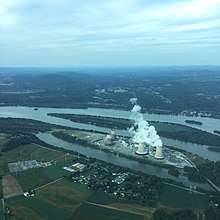
Unit 1 was scheduled to be shut down by September 2019 after Exelon announced they did not receive any commitments for subsidies from the state, rendering Exelon unable to continue operating the reactor.[26][27] TMI-1 was shut down on September 20, 2019.[28]
Incidents
In February 1993, a man drove his car past a checkpoint at the TMI nuclear plant, then broke through an entry gate. He eventually crashed the car through a secure door and entered the Unit 1 turbine building. The intruder, who had a history of mental illness, hid in the turbine building and was apprehended after four hours.[29]
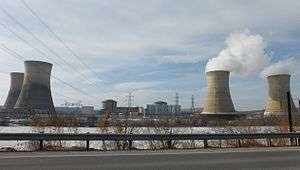
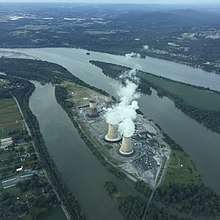
On November 21, 2009, a release of radioactivity occurred inside the containment building of TMI-1 while workers were cutting pipes. Exelon Corporation stated to the public that "A monitor at the temporary opening cut into the containment building wall to allow the new steam generators to be moved inside showed a slight increase in a reading and then returned to normal. Approximately 20 employees were treated for mild radiation exposure."[30] As of November 22, 2009, it was believed that no radiation escaped the containment building and the public was not in any danger. The inside airborne contamination was caused by a change in air pressure inside the containment building that dislodged small irradiated particles in the reactor piping system. Some of the small particles became airborne inside the building and were detected by an array of monitors in place to detect such material. The air pressure change occurred when inside building ventilation fans were started to support outage activities. The site modified the ventilation system to prevent future air pressure changes. Work continued on the project the following day. On January 24, 2010, TMI-1 was brought back online.[31]

Three Mile Island Unit 2
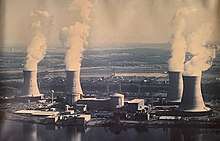
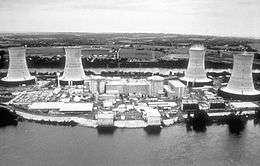
The Three Mile Island Unit 2 was also a pressurized water reactor constructed by B&W, similar to Unit 1. The only difference was that TMI-2 was slightly larger with a net generating capacity of 906 MWe, compared to TMI-1, which delivers 819 MWe. Unit 2 received its operating license on February 8, 1978, and began commercial operation on December 30, 1978. TMI Unit 2 has been permanently shut off after the Three Mile Island accident in 1979.[32]
Accident
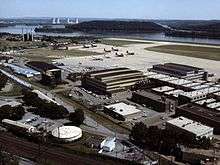
On March 28, 1979, there was a cooling system malfunction that caused a partial meltdown of the reactor core. This loss-of-coolant accident resulted in the release of an amount of radioactivity, estimated at 43,000 curies (1.59 PBq) of radioactive krypton-85 gas (half life 10 yrs), but less than 20 curies (740 GBq) of the especially hazardous iodine-131 (half life 8 days), into the surrounding environment.[4]
Nearly 2 million people were exposed to a small amount of radiation from the accident.[33] A review by the World Nuclear Association concluded that no deaths, injuries or adverse health effects resulted from the accident,[34] and a report by Columbia University epidemiologist Maureen Hatch confirmed this finding.[5][35] Because of the health concerns, the Pennsylvania Department of Health kept a registry of more than 30,000 people that lived within 5 miles of TMI at the time of the accident. The registry was kept for nearly 20 years until 1997, when no evidence was found of unusual health effects.[36] Further epidemiology studies have not shown any increase in cancer as a result of the accident.[6][7][8] However, almost $25 million was paid in insurance settlements to people who then agreed not to discuss their injuries in ongoing litigation.[37]
Unit 2 has not been operational since the accident occurred.[38]
The New York Times reported on August 14, 1993, 14 years after the accident, that the cleanup had been finished. According to the United States NRC, 2.3 million gallons of waste water had been removed.[39]
The incident was widely publicized internationally, and had far-reaching effects on public opinion, particularly in the United States. The China Syndrome, a movie about a nuclear disaster, which was released 12 days before the incident and received a tepid reception from the movie-going public, became a blockbuster hit.[40]
Unit 2 Generator
On January 22, 2010, officials at the NRC announced the electrical generator from the damaged Unit 2 reactor at TMI will be used at Shearon Harris Nuclear Plant in New Hill, North Carolina. The generator was transported in two parts, weighing a combined 670 tons. It was refurbished and installed during a refueling outage at Shearon Harris NPP in November 2010. TMI's Unit 2 reactor has been shut down since the partial meltdown in 1979.[41]
Post-accident
Exelon Corporation was created in October 2000 by the merger of PECO Energy Company and Unicom, of Philadelphia and Chicago respectively.[42] Unicom owned Commonwealth Edison. The PECO share in AmerGen was acquired by Exelon during late 2000. Exelon acquired British Energy's share in AmerGen in 2003,[43] and transferred Unit 1 under the direct ownership and operation of its Exelon Nuclear business unit.[44][45] According to Exelon Corporation, "many people are surprised when they learn that Three Mile Island is still making electricity, enough to power 800,000 households" from its undamaged and fully functional reactor unit 1.[46] Exelon viewed the plant's economics of $44/MWh as challenging due to the low price of natural gas at $25/MWh. As of 2016, the average price of electricity in the area was $39/MWh.[47]
Closure
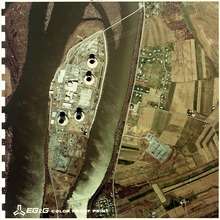
On June 20, 2017, Exelon Generation, the owners of Three Mile Island's Unit 1 sent to the Nuclear Regulatory Commission a formal notice of its intention to shut down the plant on September 30, 2019,[48] unless the Pennsylvania legislature rescues the nuclear industry, which is currently struggling to compete as newfound natural gas resources have driven down electricity prices.[49] Exelon Generation's Senior Vice President Bryan Hanson noted that once Three Mile Island was closed, it could never be reopened for use again.[48] Hanson explicitly stated the reason for the shutdown is because of the unprofitability of Unit 1. Unit 1 has lost the company over 300 million dollars over the last half-decade despite it being one of Exelon's best-performing power plants.
Shut down of Unit 1 can go in two possible directions, the first being the immediate dismantlement immediately after the radioactive fuel has been moved away from the plant. The dismantlement can proceed after the spent fuel is removed from the pool, put into storage casks, and the casks are transferred to the ISFSI pad for storage until the DOE takes them away to a DOE repository. Dismantling the plant this way will take anywhere from 8 to 10 years.[50] The second option Exelon could take is the long-term storage, which involves mothballing the plant and letting the radiation decay for up to 60 years on its own to a harmless level before completely dismantling the buildings. The advantage to the long-term storage is the lack of radiation when the dismantlement would begin but the disadvantage would be the possible lack of qualified workers at the time of dismantlement. Exelon would also have to pay for limited maintenance and security of the plant over the potential sixty years.[50] The entirety of the spent fuel will be moved to the Londonderry Township facility, which is another process that could take decades to complete.[48]
About 70 legislators signed the industry-inspired Nuclear Caucus but made no financial commitments.[49]
In April 2019, Exelon stated it would cost $1.2 billion over nearly 60 years to completely decommission Unit 1.[51] Unit 1 closed on September 20, 2019.
Seismic risk
The Nuclear Regulatory Commission's estimate of the risk each year of an earthquake intense enough to cause core damage to the reactor at Three Mile Island was 1 in 25,000, according to an NRC study published in August 2010.[52][53]
References
- "EIA - State Nuclear Profiles". www.eia.gov. United States Energy Information Administration. Archived from the original on May 19, 2017. Retrieved October 3, 2017.
- Thomas, Ryland; Williamson, Samuel H. (2019). "What Was the U.S. GDP Then?". MeasuringWorth. Retrieved April 6, 2019. United States Gross Domestic Product deflator figures follow the Measuring Worth series.
- Maykuth, Andrew (February 28, 2019). "Peach Bottom, other U.S. nuclear power plants could be running until 2054. Is it safe?". Philadelphia Inquirer. Retrieved March 25, 2019.
- "Fact Sheet on the Three Mile Island Accident". US Nuclear Regulatory Commission. Retrieved December 18, 2008.
- Maureen C. Hatch; et al. (1990). "Cancer near the Three Mile Island Nuclear Plant: Radiation Emissions". American Journal of Epidemiology. Oxford Journals. 132 (3): 397–412. doi:10.1093/oxfordjournals.aje.a115673. PMID 2389745.
- Levin RJ (2008). "Incidence of thyroid cancer in residents surrounding the three mile island nuclear facility". Laryngoscope. 118 (4): 618–628. doi:10.1097/MLG.0b013e3181613ad2. PMID 18300710.
Thyroid cancer incidence has not increased in Dauphin County, the county in which TMI is located. York County demonstrated a trend toward increasing thyroid cancer incidence beginning in 1995, approximately 15 years after the TMI accident. Lancaster County showed a significant increase in thyroid cancer incidence beginning in 1990. These findings, however, do not provide a causal link to the TMI accident.
- Hatch MC, Wallenstein S, Beyea J, Nieves JW, Susser M (June 1991). "Cancer rates after the Three Mile Island nuclear accident and proximity of residence to the plant". American Journal of Public Health. 81 (6): 719–724. doi:10.2105/AJPH.81.6.719. PMC 1405170. PMID 2029040.
- http://www.uvm.edu/~vlrs/Energy/NuclearPower.pdf
- "Accident at Three Mile Island". Policy Almanac. Archived from the original on February 7, 2009. Retrieved December 18, 2008.
- STAFF, CBS21 WEB. "History of Three Mile Island". WHP. Retrieved December 7, 2017.
- "Middletown – Three mile Island". Retrieved May 15, 2012.
- "GPU, Inc. – Company History". Retrieved April 1, 2009.
- "FirstEnergy — Company history". Retrieved April 1, 2009.
- Thompson, Charles (March 19, 2019). "Save Three Mile Island? What a difference 40 years makes". pennlive.com. Retrieved March 25, 2019.
- Bade, Gavin (May 30, 2017). "After failing to clear PJM auction, Exelon says Three Mile Island nuke will close in 2019". Utility Dive. Retrieved May 30, 2017.
- "Middletown – Three mile Island". Retrieved February 3, 2019.
- Sholtis, Brett. "Three Mile Island Nuclear Power Plant Shuts Down". Retrieved September 20, 2019.
- "NRC: Three Mile Island - Unit 2". www.nrc.gov. Retrieved March 25, 2019.
- "NRC: Emergency Planning Zones". United States Nuclear Regulatory Commission. Retrieved December 22, 2019.
- Bill Dedman, Nuclear neighbors: Population rises near US reactors, NBC News, April 14, 2011 http://www.nbcnews.com/id/42555888 Accessed May 1, 2011.
- "A Corporate History of Three Mile Island | Three Mile Island Alert". www.tmia.com. Retrieved November 11, 2016.
- "Three Mile Island". Amerigen — Exelon Corporation. Retrieved February 21, 2013.
- "Three Mile Island 1 – Pressurized Water Reactor". Nuclear Regulatory Commission. Retrieved December 15, 2008.
- DiSavino, Scott (October 22, 2009). "NRC renews Exelon Pa. Three Mile Isl reactor license". Thomson Reuters. Retrieved October 23, 2009.
- Stephanie Cooke (2009). In Mortal Hands: A Cautionary History of the Nuclear Age, Black Inc., p. 299.
- Fortin, Jacey (May 8, 2019). "Three Mile Island Nuclear Power Plant Is Shutting Down". The New York Times. ISSN 0362-4331. Retrieved May 13, 2019 – via NYTimes.com.
- Geuss, Megan (May 9, 2019). "The last reactor at Three Mile Island is shutting down". Ars Technica. Retrieved May 17, 2019.
- Sholtis, Brett. "Three Mile Island Nuclear Power Plant Shuts Down". Retrieved September 20, 2019.
- "Man Crashes Car Through Gates at Three Mile Island". Los Angeles Times. Associated Press. February 8, 1993. Retrieved October 15, 2019.
- "Three Mile Island radiation leak investigated - CNN.com". CNN. November 22, 2009. Retrieved May 25, 2010.
- "Radiation leak at Three Mile Island". ABC News — WPVI Philadelphia. Retrieved November 22, 2009.
- "Three Mile Island — Unit 2". Nuclear Regulatory Commission. Retrieved December 15, 2008.
- "Three Mile Island - Facts & Summary - HISTORY.com". HISTORY.com. Retrieved December 7, 2017.
- "Three Mile Island: 1979". World Nuclear Association. Retrieved December 18, 2008.
- "No Evidence Reactor Leak Caused Cancer". The Washington Post. March 30, 1999. Retrieved May 25, 2010.
- "Three Mile Island | TMI 2 |Three Mile Island Accident. - World Nuclear Association". www.world-nuclear.org. Retrieved December 7, 2017.
- "Settlement of Medical Claims". Scribd. Retrieved April 23, 2019.
- "Three Mile Island - Unit 2". www.nrc.gov. Archived from the original on October 4, 2006.
- "A history of the Three Mile Island nuclear plant". ABC News. May 31, 2017. Retrieved December 7, 2017.
- "FAQ for the China Syndrome". IMDb. Retrieved December 29, 2008.
- "Three Mile Island generator moving to Shearon Harris". WRAL-TV. January 22, 2010. Retrieved January 22, 2010.
- "Exelon — Merger Filing". Archived from the original on February 10, 2009. Retrieved April 1, 2009.
- "A Corporate History of Three Mile Island — Three Mile Island Alert". Retrieved April 1, 2009.
- "Exelon — Three Mile Island Unit – 1". Retrieved April 1, 2009.
- "Three Mile Island: About TMI — About Us". Retrieved April 1, 2009.
- Allen Abel, Life after a meltdown: Locals near Three Mile Island may be wary, but they aren't moving, The National Post, Saturday, March 19, 2011, p.A5
- Barrett, Paul (December 22, 2016). "States Are the Nuclear Industry's Best Hope". Bloomberg.com. Retrieved January 12, 2017.
unless the government intervenes to keep the plant running, the notorious facility's "long-term future past 2019" is in doubt.
- "Three Mile Island operator takes another step toward closing nuclear plant". PennLive.com. June 23, 2017. Retrieved December 7, 2017.
- "Three Mile Island fights once again for its nuclear survival". Philly.com. Retrieved December 7, 2017.
- Writer, AD CRABLE | Staff. "After announcement of closure, what's next for Three Mile Island nuclear plant?". LancasterOnline. Retrieved December 7, 2017.
- Maykuth, Andrew (April 5, 2019). "Three Mile Island nuclear reactor dismantling could take six decades, more than $1 billion". The Inquirer. Philadelphia. Retrieved April 6, 2019.
- Bill Dedman (March 17, 2011). "What are the odds? US nuke plants ranked by quake risk". NBC News. Retrieved April 19, 2011.
- "Hotmail, Outlook en Skype inloggen - Laatste nieuws - MSN Nederland" (PDF). Archived from the original (PDF) on May 25, 2017. Retrieved May 5, 2017.
External links
| Wikimedia Commons has media related to Three Mile Island Nuclear Generating Station. |
- Three Mile Island page on the operator's website
- Three Mile Island – Three Mile Island Alert